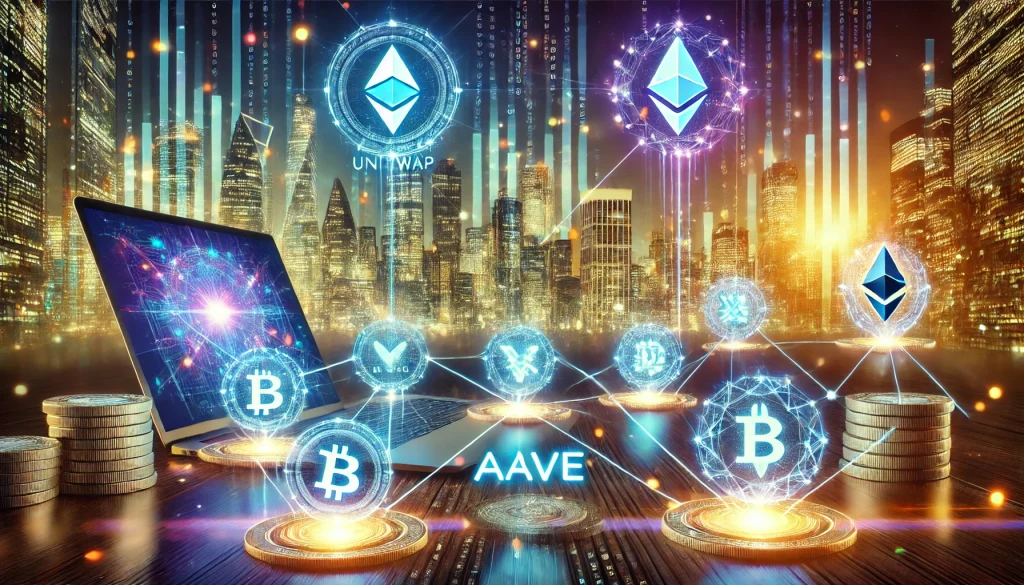As Decentralized Finance (DeFi) continues to transform the financial landscape, 2024 marks another pivotal year of growth, with several key projects driving innovation. These projects are revolutionizing the way financial services are accessed, managed, and delivered by using blockchain technology to eliminate intermediaries and promote financial inclusivity. In this article, we’ll explore the top DeFi projects to watch in 2024, highlighting their unique features and contributions to the evolving decentralized ecosystem.
Uniswap (UNI): The Leading Decentralized Exchange
One of the most well-known DeFi projects is Uniswap (UNI), a decentralized exchange (DEX) that allows users to trade cryptocurrency tokens without relying on a centralized authority. Launched in 2018, Uniswap has grown to become one of the largest and most popular DEX platforms, with over $5.6 billion in total value locked (TVL) as of 2024.
Uniswap’s innovative automated market maker (AMM) model enables users to trade tokens directly from their wallets by pooling liquidity from various sources. Unlike traditional order-book exchanges, where buyers and sellers are matched, Uniswap allows users to provide liquidity to pools, earning a share of the trading fees. This decentralized approach ensures that Uniswap can function without a central governing entity, making it more resilient and accessible.
Key Features of Uniswap:
- Liquidity Pools: Users can contribute to liquidity pools and earn fees when trades are executed.
- Governance: UNI token holders can vote on protocol upgrades, giving them a voice in the platform’s future.
- Multichain Support: In 2024, Uniswap operates across multiple blockchain ecosystems, including Ethereum, Polygon, and Binance Smart Chain, making it accessible to a wide range of users.
Uniswap’s ongoing commitment to decentralization and user empowerment positions it as a key player in the DeFi space. With the addition of advanced liquidity provision features in 2024, Uniswap is making decentralized trading even more efficient and cost-effective.
Aave (AAVE): Pioneering Decentralized Lending and Borrowing
Aave (AAVE) has emerged as one of the leading decentralized lending platforms, offering users the ability to borrow and lend a wide range of cryptocurrencies without intermediaries. Since its launch, Aave has introduced several innovative features that differentiate it from other DeFi lending protocols, and in 2024, it continues to play a critical role in the DeFi ecosystem with over $12 billion in TVL.
Aave’s unique approach allows users to switch between fixed and variable interest rates, giving borrowers more flexibility based on their preferences and market conditions. This rate-switching capability has attracted a growing user base, making Aave one of the most trusted platforms for decentralized lending and borrowing.
Key Features of Aave:
- Staking and Safety Module: Users can stake their AAVE tokens to help secure the network and earn additional rewards.
- Flash Loans: Aave introduced flash loans, which allow users to borrow without collateral as long as the loan is repaid within the same transaction block.
- Multi-Collateral Support: Aave supports a wide variety of assets as collateral, enabling users to borrow against their crypto holdings efficiently.
In 2024, Aave continues to innovate by offering cross-chain lending services, making it easier for users to access liquidity across different blockchain networks. Its focus on security and governance has solidified its position as a top choice for DeFi users looking to maximize their crypto assets.
Balancer (BAL): Automated Portfolio Management
Balancer (BAL) is another standout in the DeFi space, providing a decentralized platform for automated portfolio management and liquidity provision. Unlike traditional asset management tools, Balancer allows users to create liquidity pools with multiple assets, which automatically rebalance to maintain a desired asset ratio. This innovative approach minimizes management fees while offering competitive yields for liquidity providers.
With over $919 million in TVL in 2024, Balancer has positioned itself as a go-to platform for investors looking to create diversified crypto portfolios without the need for constant rebalancing. The platform’s smart pools automatically adjust allocations based on market conditions, reducing risk for users and ensuring a more efficient trading experience.
Key Features of Balancer:
- Smart Pools: Automatically rebalance portfolios to maintain asset ratios.
- Multiple Asset Support: Users can create pools with up to eight different assets, making it easy to diversify investments.
- Customizable Pools: Public, private, and smart pools cater to different investor preferences and risk levels.
Balancer’s focus on automation and flexibility continues to attract both retail and institutional investors, making it a leading platform for DeFi portfolio management in 2024.
EigenLayer: Restaking for Enhanced Security
A newer but fast-growing project, EigenLayer introduces the concept of restaking, where Ethereum is used to secure third-party protocols. This protocol aims to enhance the security of other DeFi applications by allowing users to stake their ETH and participate in securing multiple protocols, all while earning additional rewards. EigenLayer has quickly gained traction, with over $15 billion in TVL as of 2024.
Restaking enables DeFi projects to leverage the security of Ethereum without needing to build their own validator infrastructure, making it an attractive option for smaller projects looking to scale securely. EigenLayer’s decentralized governance model also ensures that users have a say in how the protocol evolves.
Key Features of EigenLayer:
- Restaking: Allows users to stake ETH to secure multiple protocols and earn rewards.
- Decentralized Governance: EigenLayer is governed by its community, with token holders voting on key decisions.
- Security Services: Provides enhanced security for DeFi applications by leveraging Ethereum’s validator network.
In a DeFi landscape that increasingly emphasizes security and scalability, EigenLayer’s approach to restaking offers a promising solution for protocols looking to grow while maintaining a high level of security.
Other Prominent DeFi Projects to Watch
In addition to Uniswap, Aave, Balancer, and EigenLayer, several other DeFi projects are shaping the future of decentralized finance in 2024:
- MakerDAO (MKR): MakerDAO continues to lead in the stablecoin space with its DAI token, offering a decentralized alternative to traditional stablecoins. With a focus on governance and stability, MakerDAO remains a key player in DeFi.
- Compound (COMP): Another top lending platform, Compound allows users to lend and borrow a wide range of assets, offering competitive interest rates and a robust governance model.
- Lido (LDO): Lido’s liquid staking protocol enables users to stake Ethereum and other assets while retaining liquidity, making it a popular choice for stakers looking to maximize their rewards.
These projects, along with the aforementioned platforms, represent the cutting edge of innovation in DeFi, each contributing to the ecosystem in unique ways.
The Future of DeFi in 2024 and Beyond
As we look to the future, DeFi shows no signs of slowing down. The rise of cross-chain interoperability, scalability solutions like Layer 2 protocols, and decentralized governance models are all driving the next wave of DeFi innovation. However, challenges remain, particularly in terms of security and regulatory compliance. As more users flock to DeFi platforms, ensuring the safety of smart contracts and developing clear regulatory frameworks will be critical to sustaining growth.
Nevertheless, the ongoing development of projects like Uniswap, Aave, Balancer, and EigenLayer demonstrates that the DeFi ecosystem is more robust and promising than ever. These platforms are not only transforming the financial landscape but also paving the way for a more inclusive and decentralized future.


